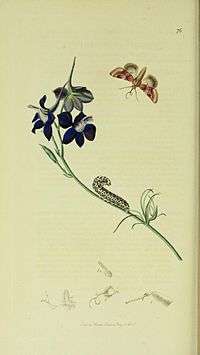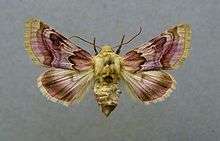Periphanes
Periphanes is a monotypic moth genus of the family Noctuidae first described by Jacob Hübner in 1821.[1] Its only species, Periphanes delphinii, the pease blossom, was first described by Carl Linnaeus in his 1758 10th edition of Systema Naturae.[2] It can be found from Afghanistan and the steppe areas of Central Asia and Anatolia up to the area surrounding the Mediterranean Sea and north-western Africa.

| Periphanes | |
|---|---|
 | |
| Scientific classification | |
| Kingdom: | |
| Phylum: | |
| Class: | |
| Order: | |
| Family: | |
| Genus: | Periphanes Hübner, 1821 |
| Species: | P. delphinii |
| Binomial name | |
| Periphanes delphinii | |
| Synonyms | |
| |
Description
Pair of spines on tibia stout and more crooked, where the inner very long. Mid and hind tibia spineless. Forewings with more or less acute apex.[3]
Technical description and variation
C. delphinii L. (501). Male forewing purplish pink, paler along outer margin and fringe, deepest in basal area and beyond middle; basal area edged by a pale and pink trilobed line; orbicular stigma ochreous, obscure; reniform large, irregular, edged with brownish purple, attached to the median shade, which with the double postmedian line and space beyond forms an irregular darker band; hindwing dirty ochreous, with fuscous veins and border, the extreme margin pink.Female darker, with a grey suffusion over both wings. — the form darollesi Oberth. (50 .) found in Algeria, Armenia, and W. Turkestan is much paler. — Larva violet grey; dorsal line black edged with yellow; sublateral bands broadly yellow; thoracic plate black, anal plate yellow; the whole body studded with black tubercles.[4]The wingspan is 30–36 millimetres (1.2–1.4 in).
Biology
The moths fly from May to June.
The larvae primarily feed on Delphinium consolida and Aconitum napellus.
References
- Savela, Markku. "Periphanes Hübner, 1821". Lepidoptera and Some Other Life Forms. Retrieved January 22, 2019.
- Savela, Markku. "Periphanes delphinii (Linnaeus, 1758)". Lepidoptera and Some Other Life Forms. Retrieved January 22, 2019.
- Hampson, G. F. (1894). The Fauna of British India, Including Ceylon and Burma: Moths Volume II. Taylor & Francis – via Biodiversity Heritage Library.
- Warren. W. in Seitz, A. Ed., 1914 Die Großschmetterlinge der Erde, Verlag Alfred Kernen, Stuttgart Band 3: Abt. 1, Die Großschmetterlinge des palaearktischen Faunengebietes, Die palaearktischen eulenartigen Nachtfalter, 1914
